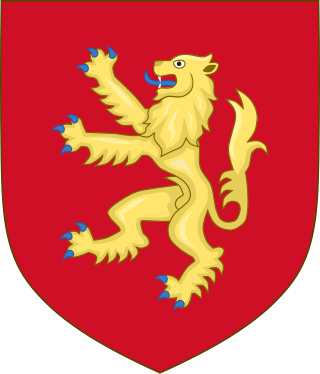
Duke of Norfolk is a title in the peerage of England, and is the premier non-royal peerage. The seat of the Duke of Norfolk is Arundel Castle in Sussex, although the title refers to the county of Norfolk. The current duke is Edward Fitzalan-Howard, 18th Duke of Norfolk. The dukes have historically been Catholic, a state of affairs known as recusancy in England.

Earl Marshal is a hereditary royal officeholder and chivalric title under the sovereign of the United Kingdom used in England. He is the eighth of the great officers of State in the United Kingdom, ranking beneath the Lord High Constable of England and above the Lord High Admiral. The dukes of Norfolk have held the office since 1672.
Earl of Norfolk is a title which has been created several times in the Peerage of England. Created in 1070, the first major dynasty to hold the title was the 12th and 13th century Bigod family, and it then was later held by the Mowbrays, who were also made Dukes of Norfolk. Due to the Bigods' descent in the female line from William Marshal, they inherited the hereditary office of Earl Marshal, still held by the Dukes of Norfolk today. The present title was created in 1644 for Thomas Howard, 18th Earl of Arundel, the heir of the Howard Dukedom of Norfolk which had been forfeit in 1572. Arundel's grandson, the 20th Earl of Arundel and 3rd Earl of Norfolk, was restored to the Dukedom as 5th Duke upon the Restoration in 1660, and the title continues to be borne by the Dukes of Norfolk.

Ralph Neville, 1st Earl of WestmorlandEarl Marshal, was an English nobleman of the House of Neville.
John Holland, 1st Duke of Exeter, 1st Earl of Huntingdon, KG, of Dartington Hall in Devon, was a half-brother of King Richard II (1377–1399), to whom he remained strongly loyal. He is primarily remembered for being suspected of assisting in the downfall of King Richard's uncle Thomas of Woodstock, 1st Duke of Gloucester (1355–1397) and then for conspiring against King Richard's first cousin and eventual deposer, Henry Bolingbroke, later King Henry IV (1399–1413).

Earl of Arundel is a title of nobility in England, and one of the oldest extant in the English peerage. It is currently held by the Duke of Norfolk, and it is used by his heir apparent as a courtesy title.

Thomas Fitzalan, 5th Earl of Arundel, 10th Earl of SurreyKG was an English nobleman, one of the principals of the deposition of Richard II, and a major figure during the reign of Henry IV.

Richard Fitzalan, 4th Earl of Arundel, 9th Earl of Surrey, KG was an English medieval nobleman and military commander.

Earl of Nottingham is a title that has been created seven times in the Peerage of England. It was first created for John de Mowbray in 1377, at the coronation of Richard II. As this creation could only pass to his legitimate heirs, it went extinct on his death in 1383. It was re-created for his younger brother Thomas de Mowbray in the same year, however. This branch of the family became Dukes of Norfolk, and the title would descend with them until John de Mowbray died without male heirs in 1476.

Baron Segrave (Seagrave) is a title in the Peerage of England. It was created by writ in 1283 for Nicholas de Segrave, and the title is drawn from a village in Leicestershire now spelled Seagrave.

Earl of Surrey is a title in the Peerage of England that has been created five times. It was first created for William de Warenne, a close companion of William the Conqueror. It is currently held as a subsidiary title by the Dukes of Norfolk.
The Chief Butler of England is an office of Grand Sergeanty associated with the feudal Manor of Kenninghall in Norfolk. The office requires service to be provided to the Monarch at the Coronation, in this case the service of Pincera Regis, or Chief Butler at the Coronation banquet.

John (III) de Mowbray, 4th Baron Mowbray was an English peer. He was slain near Constantinople while en route to the Holy Land.
Events from the 1390s in England.
Joan de Beauchamp, Baroness Bergavenny was an English noblewoman, and the wife of William de Beauchamp, 1st Baron Bergavenny of the Welsh Marches.
Elizabeth Fitzalan, Countess of Arundel, Countess of Surrey, was a member of the Anglo-Norman Bohun family, which wielded much power in the Welsh Marches and the English government. She was the first wife of Richard FitzAlan, a powerful English nobleman and military commander in the reigns of Edward III and Richard II. She was the mother of seven of his children, and as the wife of one of the most powerful nobles in the realm, enjoyed much prestige and took precedence over most of the other peers' wives.








